A Little Background on the French Macaron
There are some foods that can be improved upon. This is not one of them. For the best results, don’t mess with the french macaron. This is the original fabulous french macaron recipe. It’s all about ratios and when you mess with ratios, you no longer have a macaron. You have a grossly adulterated American mockaroon that is laden with sugar and not a lot of flavor. Put down those bubblegum and cotton candy extracts, Jackson. Let’s pick up fresh fruit instead.
Let’s look at how to choose a good recipe and then how to prepare the fabulous french Macaron. This cookie is difficult enough. We don’t need a recipe that isn’t tried and tested to be consistent. Given it took me several months and hundreds of dollars in wasted ingredients on horrible recipes, I want you to have better success than I did. There are a few tips below to help you perfect the world’s most difficult cookie recipe.
Choose your French Macaron Recipe Wisely
When searching for a French Macaron recipe, I have one main suggestion: Do NOT trust a source that doesn’t show you the inside of their macarons. If they don’t show you, assume there are issues with the recipe, as often times, I’ve had those fail. The cookies should have a nice full shell and not hollow. The texture should be soft and not hard or chalky. They should look like the following on the inside.
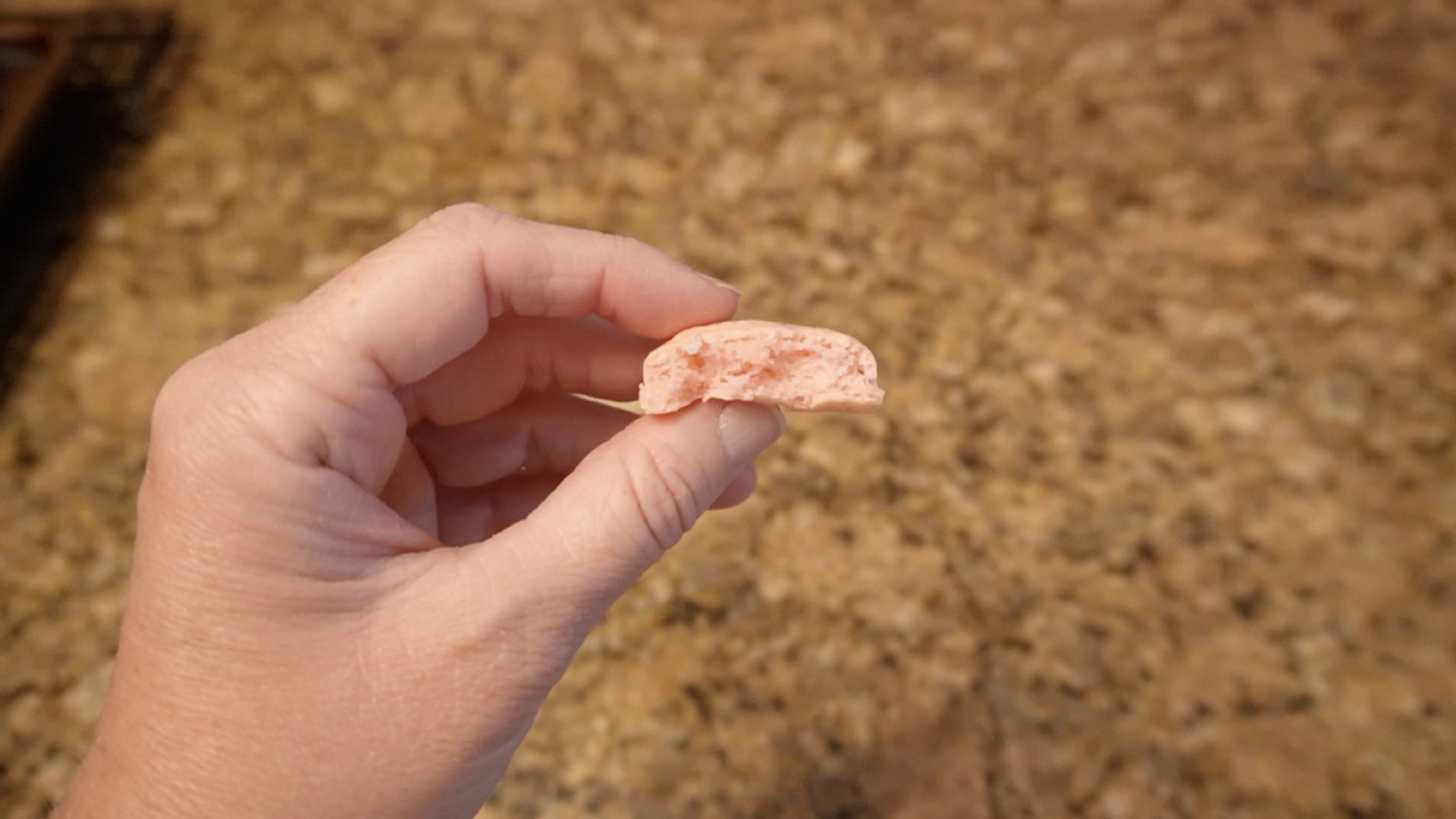
Notice the soft texture and the shell collapses easily when bitten into it. You want a chewy texture on the inside, not crispy or cake like. The shell should collapse easily under the weight of your teeth. The shell should be full of meringue.
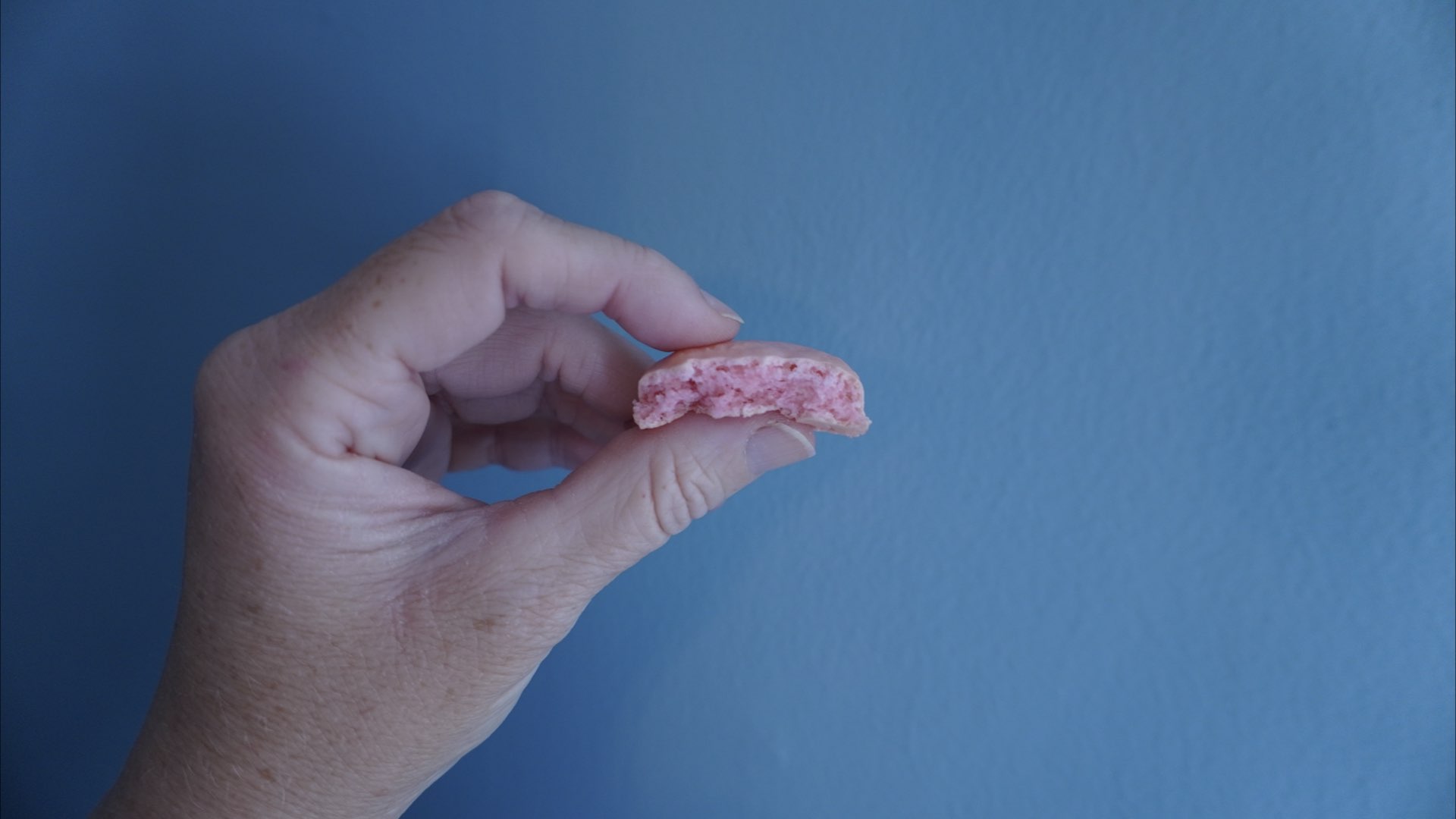
Likewise, there shouldn’t be large pockets of air or hollow spaces. A few air bubbles is okay, that often happens if you get impatient and whisk the eggs on a higher speed or the eggs were cold when you whipped them up. You don’t want them to be excessive, however. You want to taste that meringue cookie!

Now that you’ve seen the inside of my cookies, let me prepare you for another reality: hollow cookies happen to the best of us. So do cracks, and footless, lopsided, burnt, undercooked cookies. This is okay. That is how you learn. I made some no so fabulous french macaron recipe blunders.
The Search for the Perfect Recipe
Despite failing repeatedly while trying to master the world’s most difficult cookie, I kept searching for that perfect recipe or explanation for months. I wrote down every recipe I came across and put each one in a spreadsheet. One by one, I tried them. One by one, I failed. But I kept going as I was determined to succeed.
I found so many inconsistent recipes and strange outliers that I started looking outside of American sources. And that is when I found some success! Somehow, people have mixed up the Italian meringue method with the French meringue methods over here and a lot of the “no rest” cookie recipes are a Frankenrecipe of the two methods with loads more sugar. This is where many failed batches come from. It’s not you. It’s the recipe.
I started with the British baking shows and then anything French, German, Japanese, Chinese or pretty much any language I had to translate. I learned more from those sources than I should ever need. My first successful recipe was from a French site using one of the original recipes created in the late 1800’s. Since then, I’ve developed my own recipe to suit our climate which has high humidity and to bake a smaller batch as I was just learning.
I practiced for months and had the help of one of my husband’s exchange students tasting them until one day he said “these are just like the ones in Paris!” Such an exciting day as I’ve since had several others tell me these are better than those they have found in larger cities or reminded them of France. And I intended to keep this recipe a secret and take it to my grave.
I imagined getting wealthy baking macarons and setting up my own little bakery. Reality set in quickly as I peered out of my window wishing I could simply drive down to the store for supplies without feeling as though the world will collapse around me. The fear of germs, the need for perfection and my inability to stop obsessively cleaning the kitchen for the third time to calm my nerves prevents my dreams from coming true. Even giving away food makes me worry for days that I did something wrong and people will be angry with me. How is someone who is agoraphobic, resulting from years of obsessive compulsive disorder going to make a living when she wastes countless hours washing already clean dishes?
One day, a friend asked me to teach her how to make them. She wanted to bake them for her wedding anniversary. I was very tempted to say no and nearly did. And then I thought: “What if my purpose is to teach others to make macarons?” I mean, I do live in a town that isn’t particularly known for culinary delights. Many are happy with those sad Americanized, overly sweet no rest “mockaroons.” Things flavored with artificial cotton candy, bubblegum and toasted marshmallow.
In the end, I agreed to help her and was so pleased that I did. I enjoyed the fellowship of having a friend over and teaching. I really enjoyed the satisfaction of seeing another person create the most difficult cookie successfully on her own and her face light up at seeing the feet and shiny tops she created. Months have passed and I have finally decided to put the recipe up for others. So without further ado, here is my “Top Secret Macaron Recipe.” Time to start paying attention!
Step-By-Step Instructions
Let’s do a pictorial step-by-step on how to make this fabulous french macaron recipe once and for all. It’s a bit tricky, but it’s so worth it. I know these pictures aren’t ideal, but please be gentle with me. Remember: One of my arms is barely working and I’m very new to taking photos of food and sharing recipes. I am sure I will improve along the way. If anything is unclear in the meantime, just ask. I’m happy to help clear up any confusion along the way. I want you to become successful at baking delicious macarons. And stick around. I’m bound to improve on my photography and baking skills with time at physical therapy along with practicing.
Step 1: Whisk the Egg Whites
In a large bowl, whisk the eggs and sugar on a low speed. At first it will be foamy and very loose. Keep beating and don’t increase that speed. The higher the speed, the more pockets of large air will end up in your meringue. This makes the mixture more prone to collapsing and leads to hollow or airy shells.
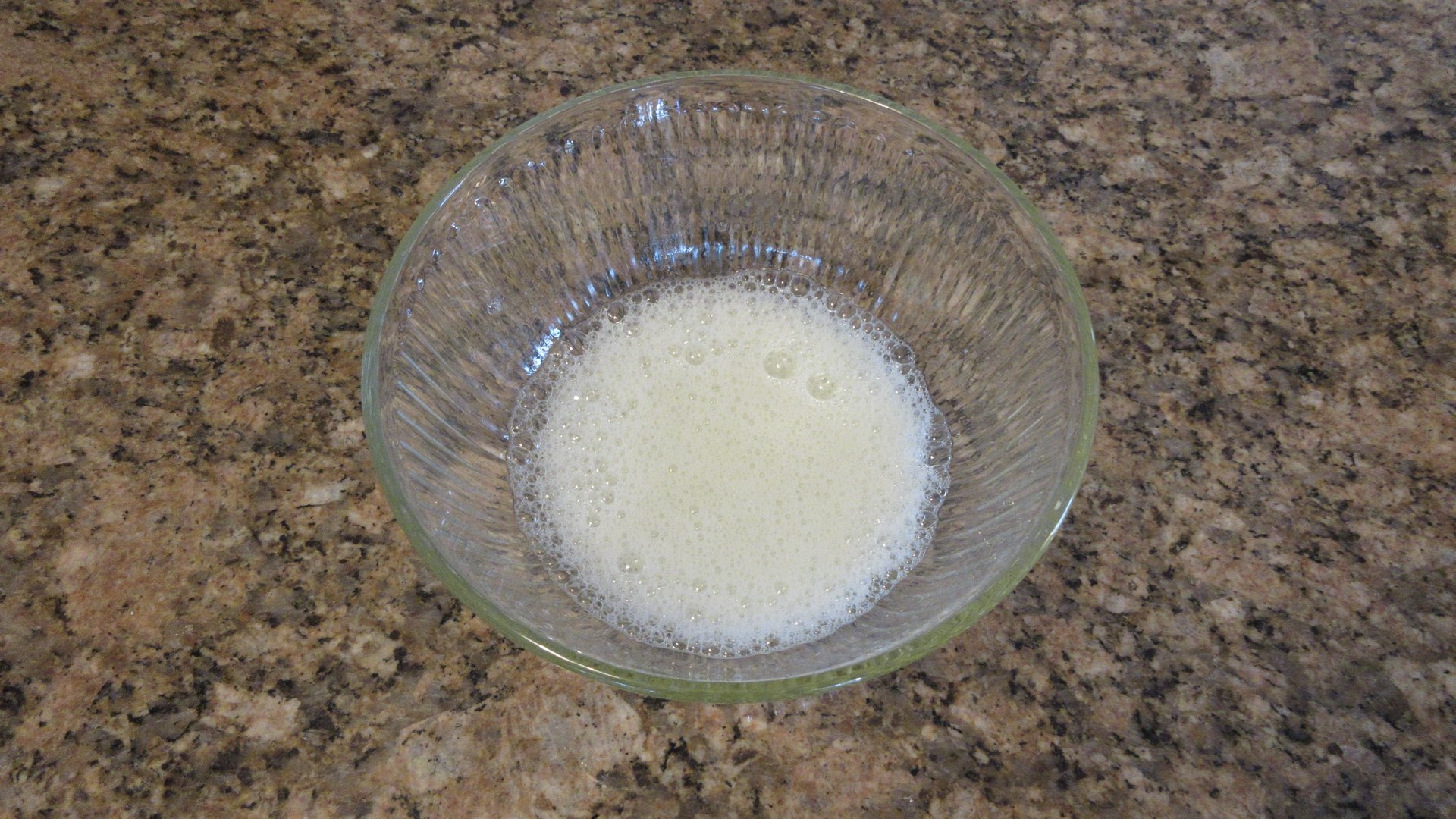
When the meringue thickens and you see tracks forming, you are close. Look for the egg whites to flop over when you remove the beater forming very soft peaks like pictured below. The peak should curl back into the batter. The bowl of meringue should be able to flip upside down and the whites will stay put. If they start to slide when you start to tilt the bowl, beat the mixture a little longer.
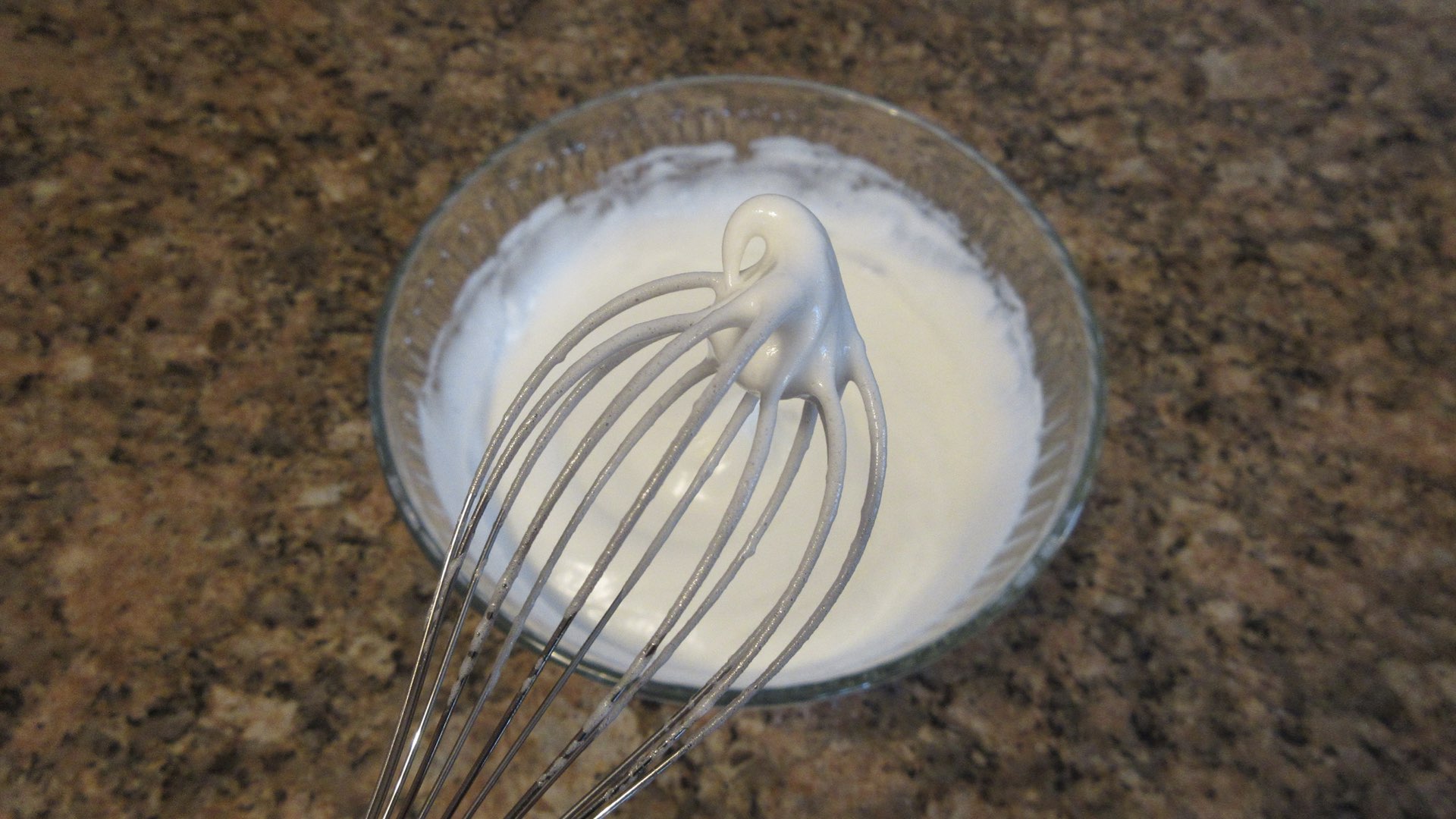
This is the stage you want to add your food coloring. Gel, powdered or paste works best. A few drops will do when using gel whereas a whole bottle could be needed for liquid food coloring.
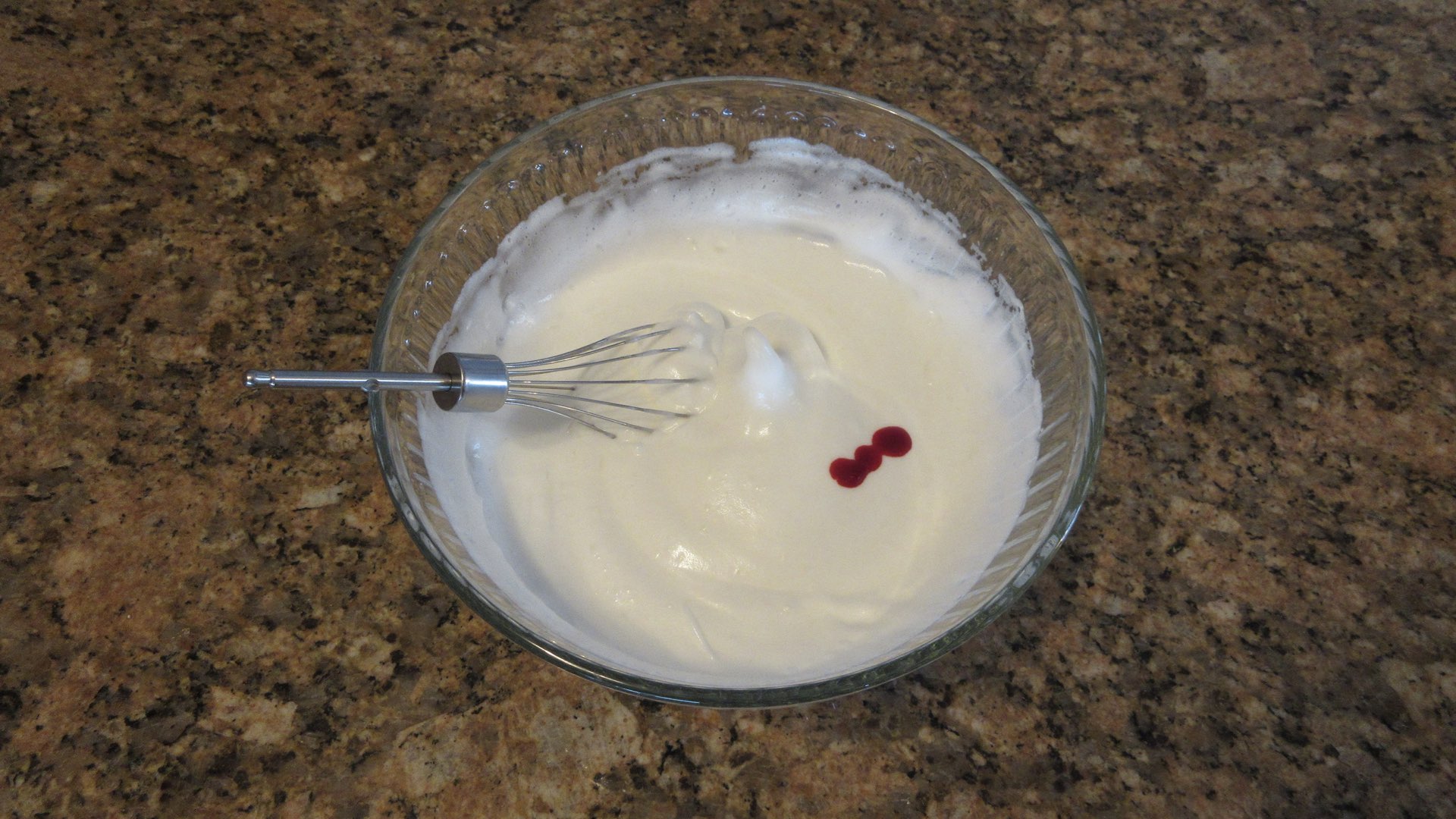
Mix in the food coloring on low until just combined. You do not want want to over mix the meringue at this stage. You want that little beak to curl down just like before. Maybe a wee bit little prouder. Keep the meringue nice and soft.
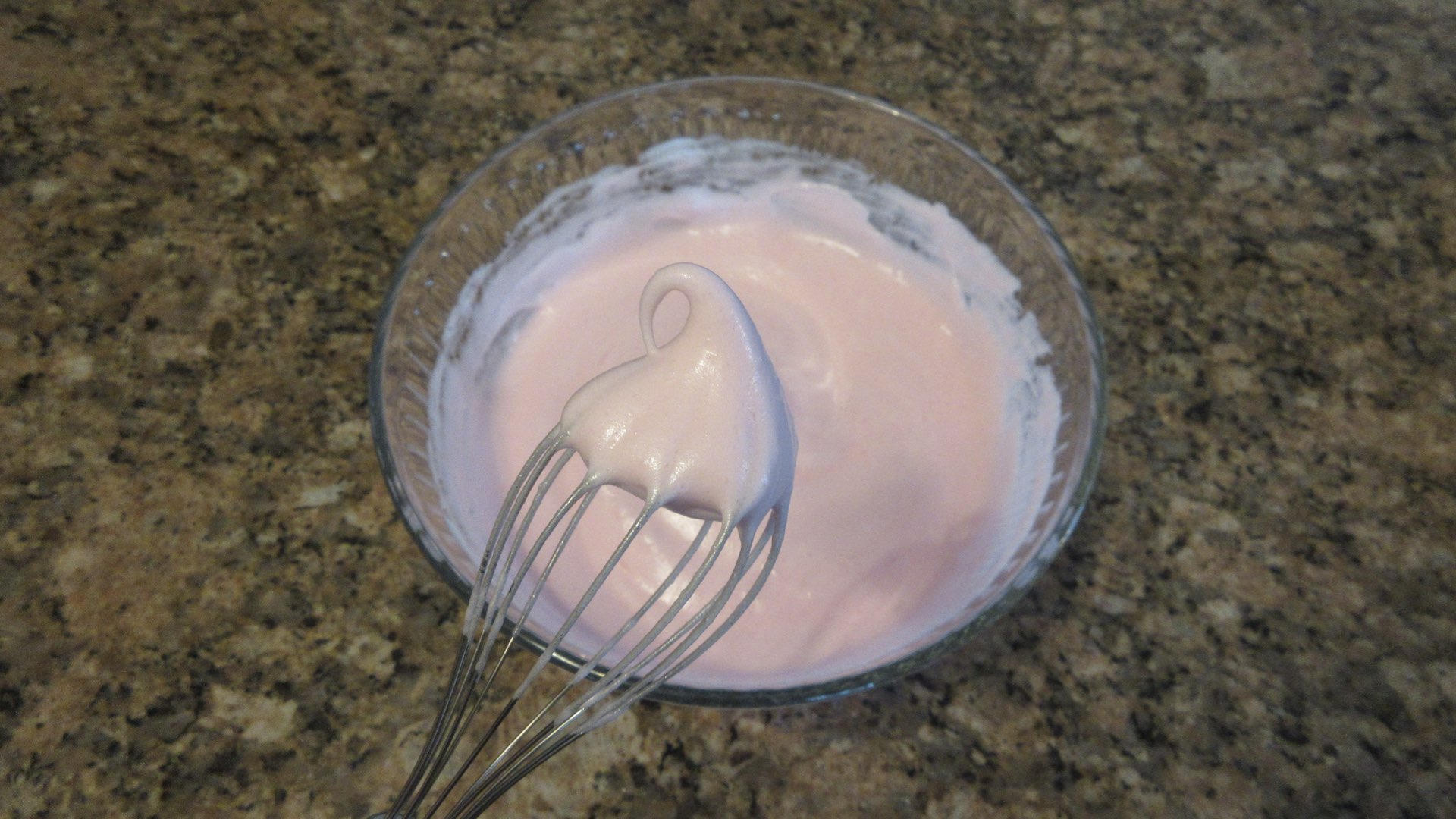
Step 2: Perform the Macronage
Sift together the almond flour and powdered sugar in a separate bowl. You may want to sift the ingredients a few times to help create air into the mixture, incorporate the flour and sugar evenly and ensure there are no lumps in either ingredient.

Next, add all the almond mixture into the whipped egg whites. You are going to start to fold in the ingredients. Go around the outside and through the middle. This is just like making an angel food cake.


The batter will start to become shiny and deflate. When all the ingredients are combined and you no longer see any flour mixture, lift the spatula.
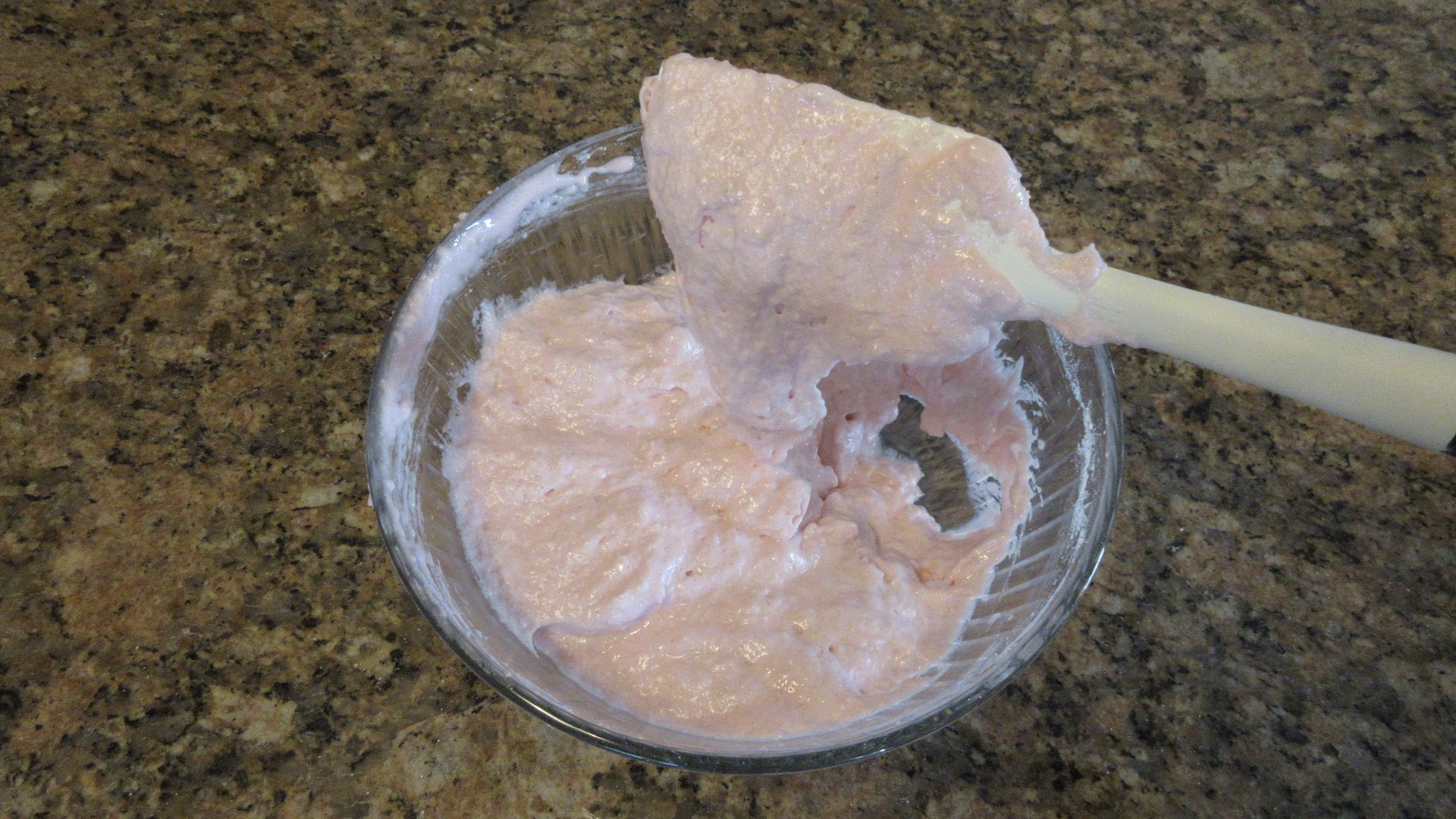
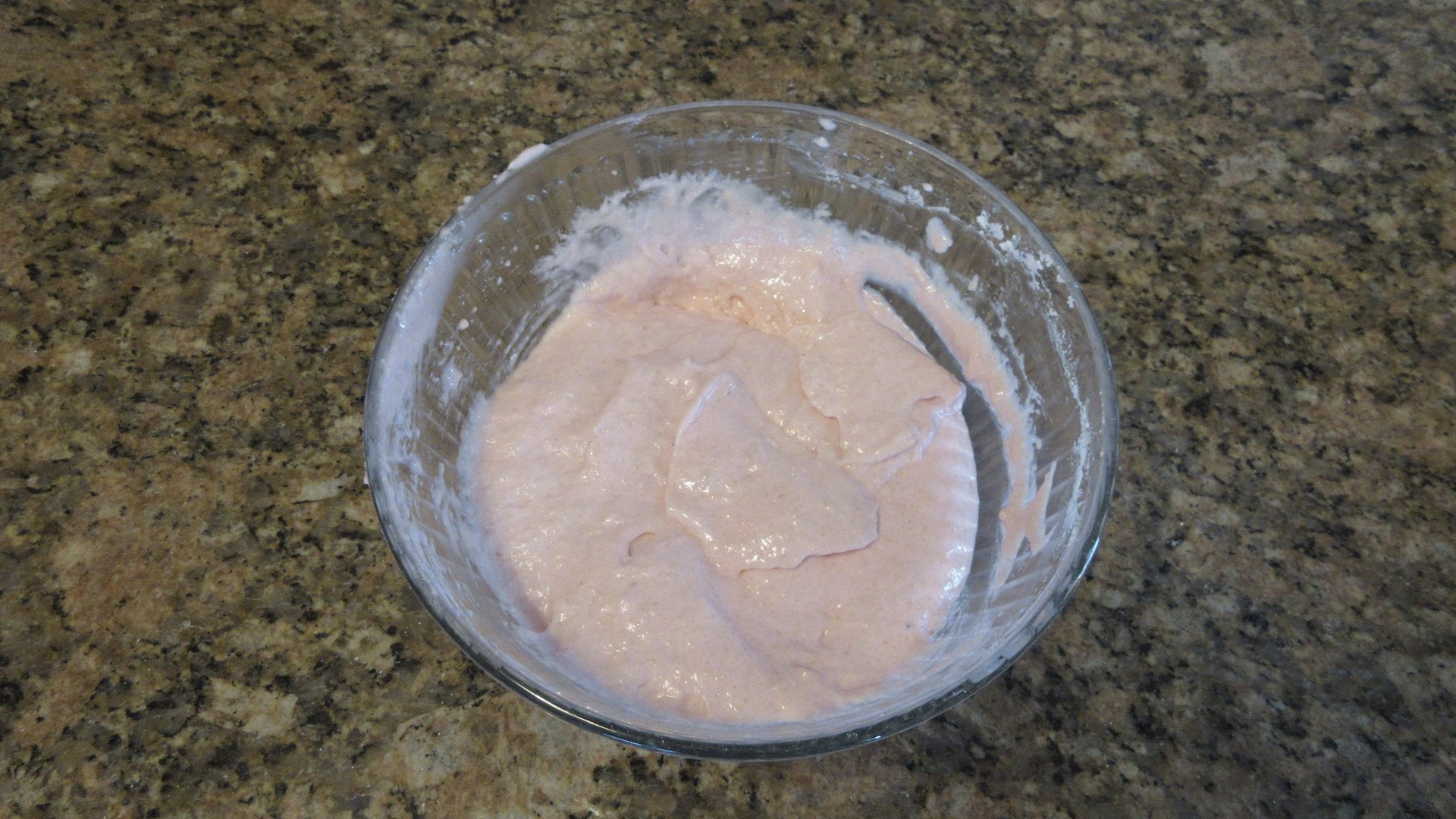
If the batter clings to the spatula, give it a few turns. However, if the batter falls off in a ribbon into the batter like this, it’s very close to being ready. Let it sit and see if the dripped batter sinks back into the mixture within a minute. If not, fold one more time. Continue to do this and check with each fold. Do not over-mix. Over-mixing will lead to flat and hollow shells. If you are a beginner, stopping at this step or even a few folds earlier may be ideal.
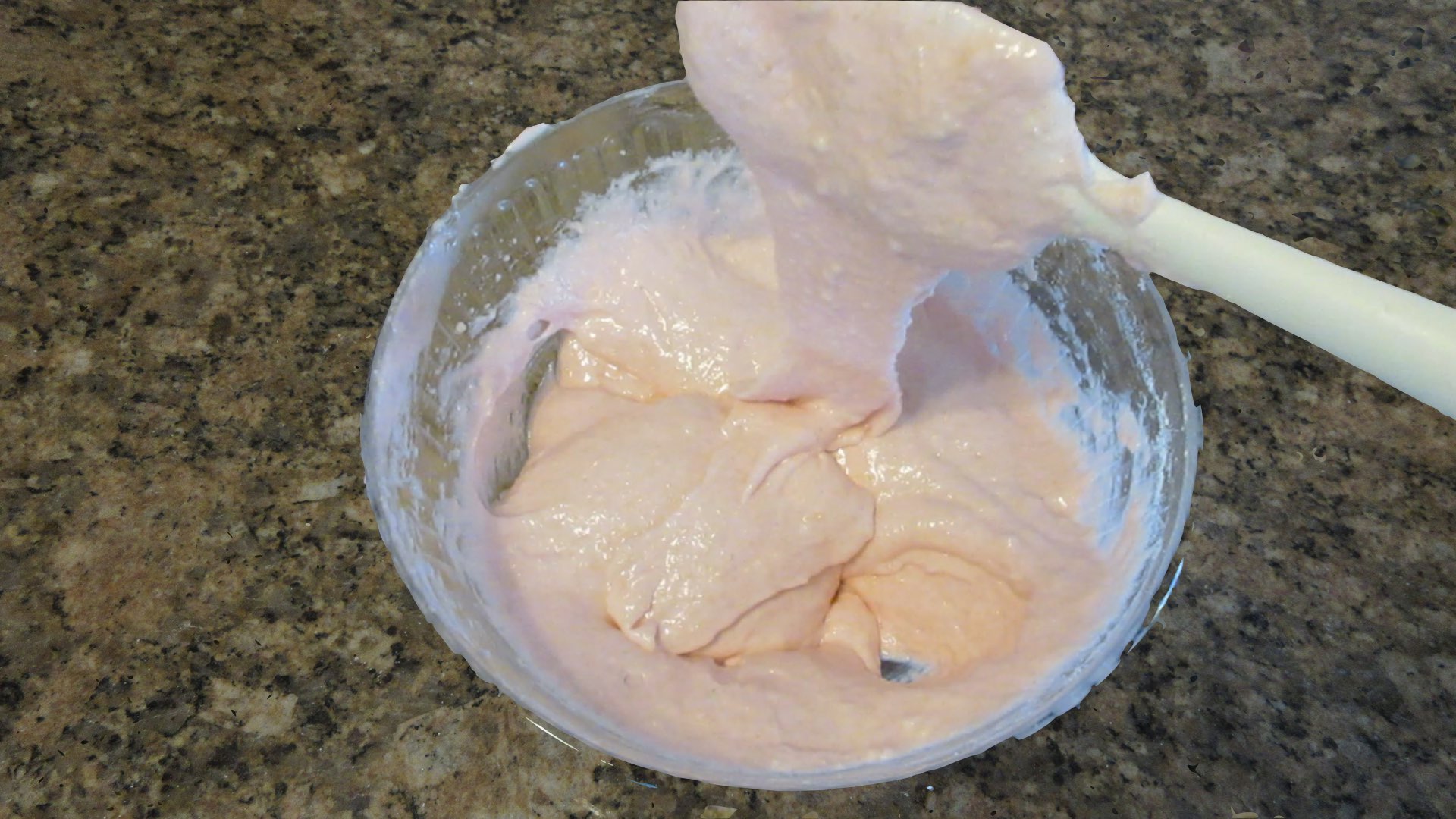
The batter below is often thought to be perfect, but I actually recommend stopping prior to this stage because it can often deflate too much. By the time you finish transferring it to the piping bag and squeezing out the batter, you often end up with hollow and flat shells.
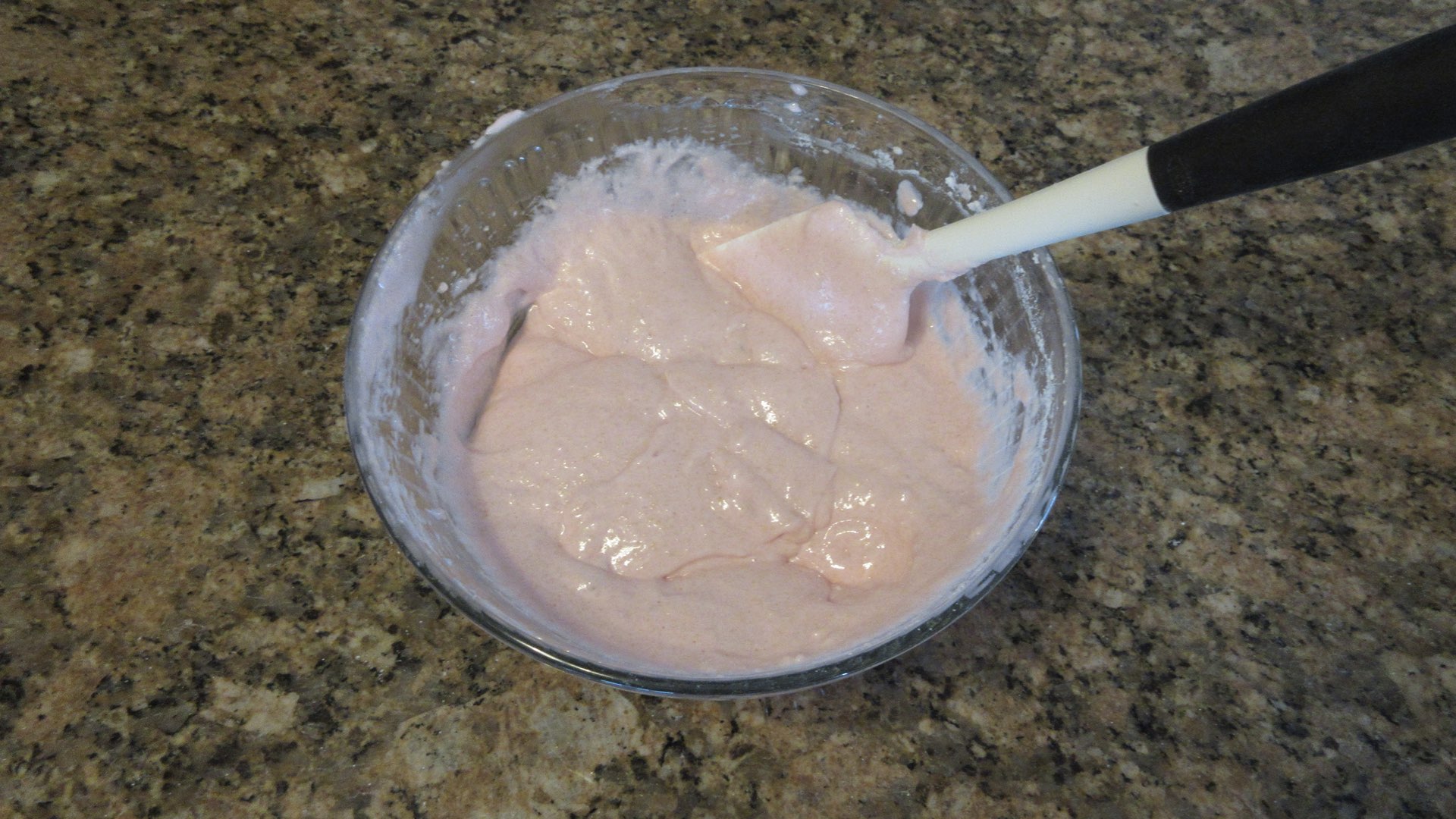
Step 3: Pipe and Dry the Macarons
Once you decide when to stop folding based on the advice above, move the mixture into a piping bag taking care not to deflate the batter further. The mixture should pour in easily. I like to use a round #12 piping tip for better control.
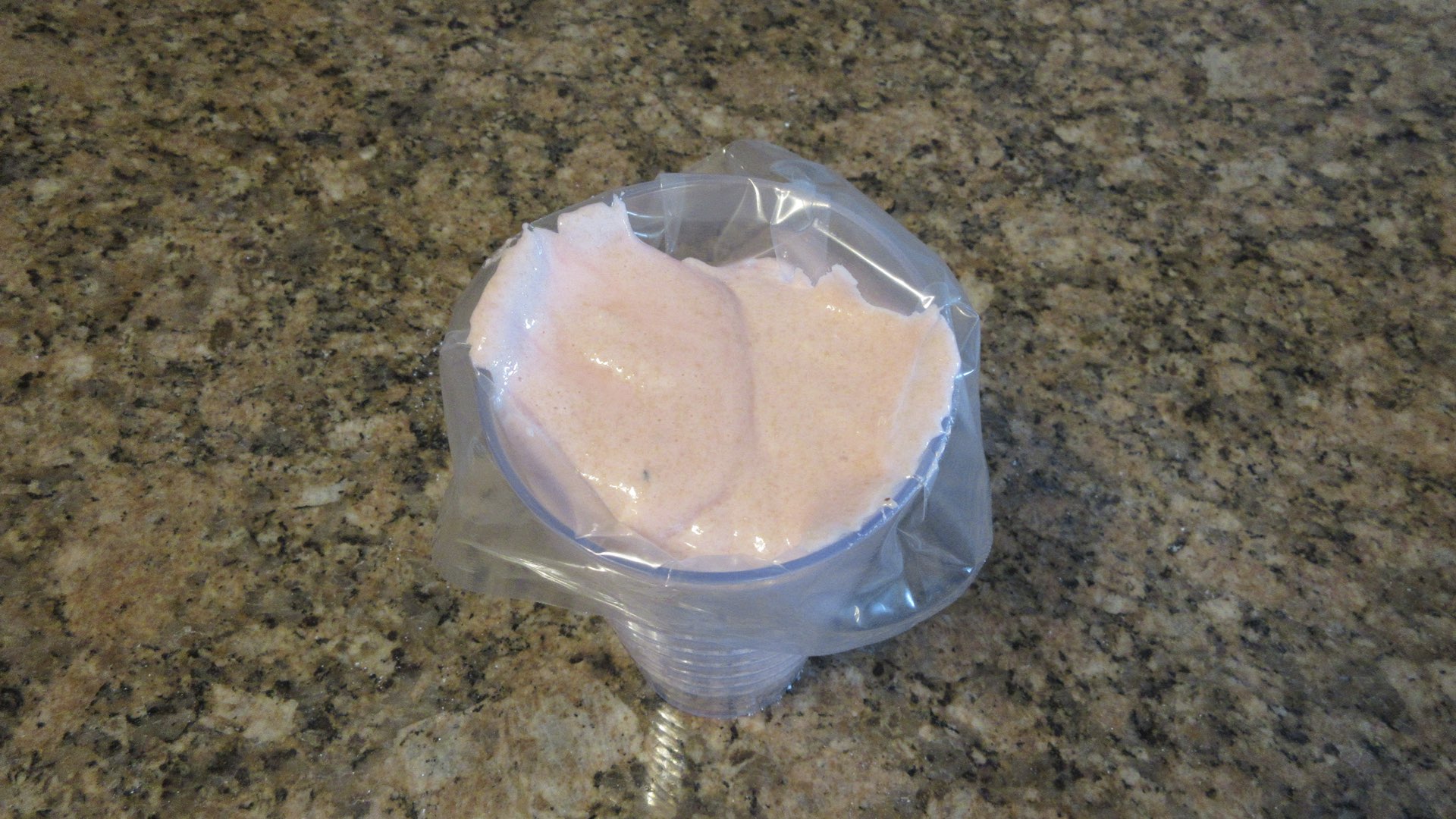
With even pressure, squeeze a small amount of batter onto parchment paper or a silicone mat until you have a circle, roughly 1 1/2 inch (3.81cm) in size. Stop squeezing and lift the piping bag. Pipe the next macaron shell approximately 2 inches (5cm) or so away from the first.
Your batter will start to settle naturally and the piping marks will disappear. If they do not fade within one minute, ever so carefully, you may want to tap the tray lightly on the counter. I skip this step as I have an injured shoulder. It’s purely for cosmetic reasons and tapping them too firmly will collapse the meringue and ruin the shells. Let sit until a skin forms and you can touch the batter without any transferring on your finger. Do be mindful of food safety regulations and don’t let them sit for more than the recommended allowances for raw eggs.
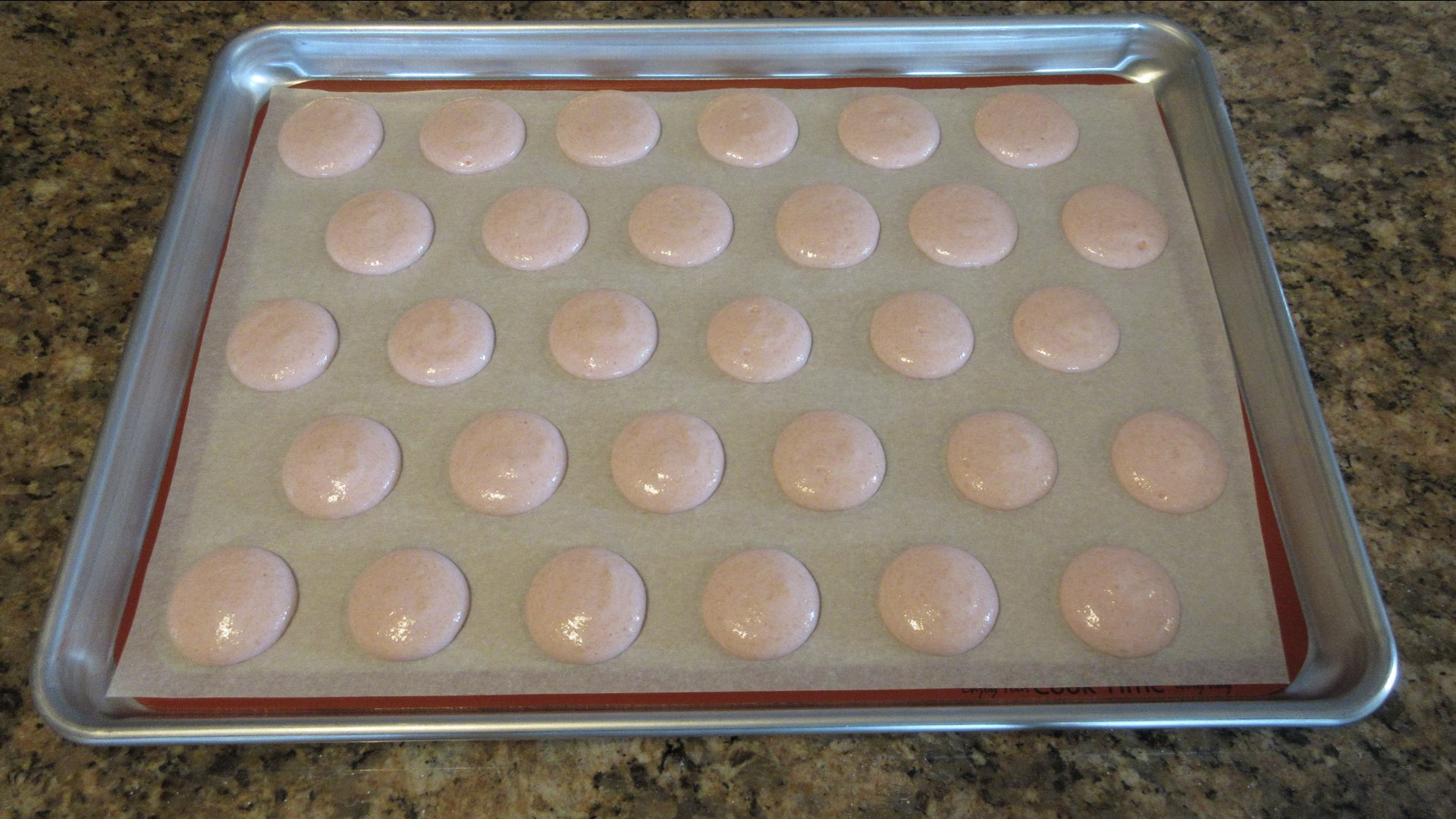
Step 4: Bake Your French Macarons
You will want to bake these low and slow. If using a silicone mat, you may have to increase your time a minute or two as opposed to when using parchment paper.
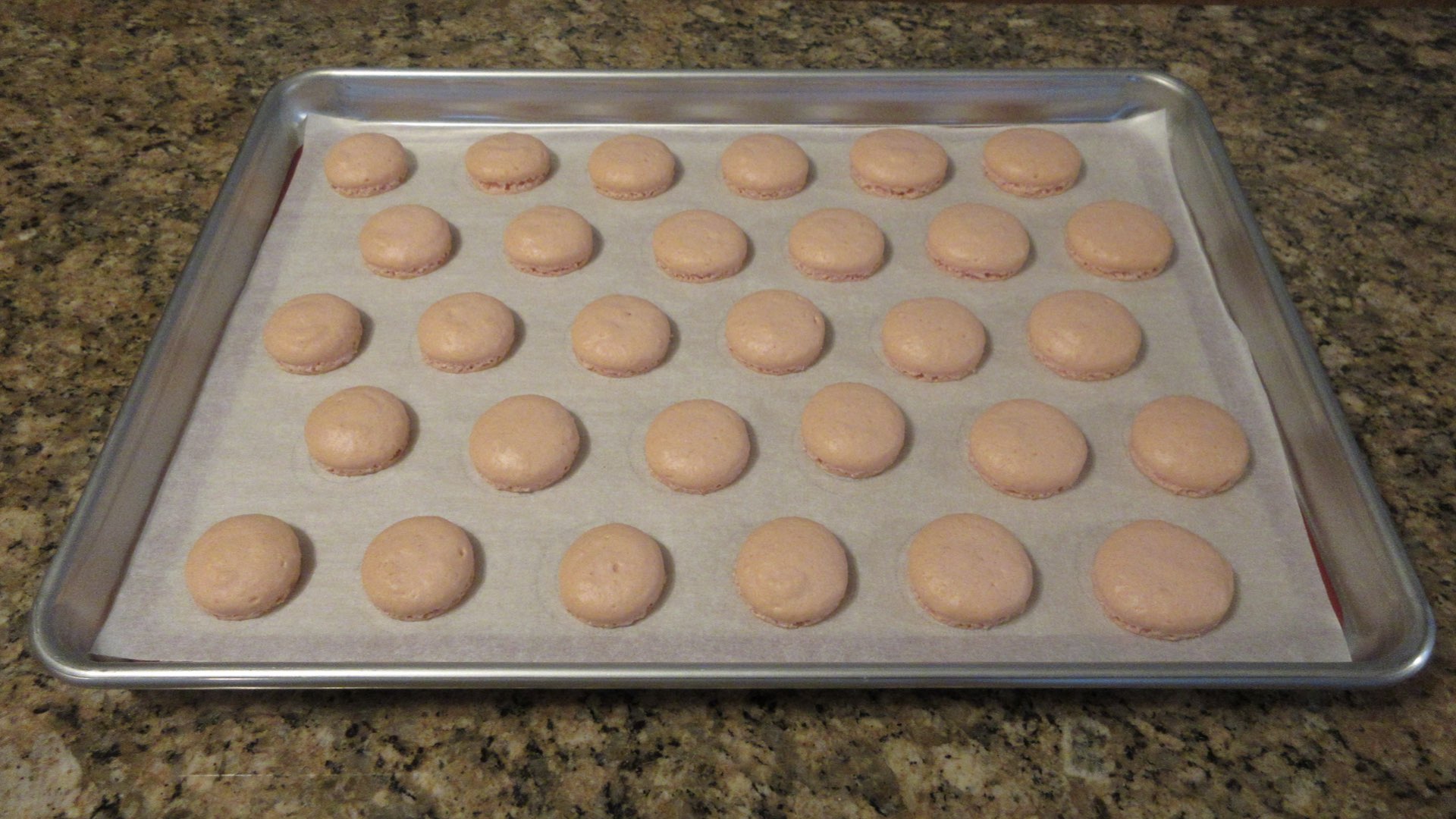
Fill with your favorite filling. Enjoy! If all goes well, you’ll have nice feet and full cookies. If not, eat them anyway. They taste the same. Just ask Macaron Maggie and her pal Raymond.
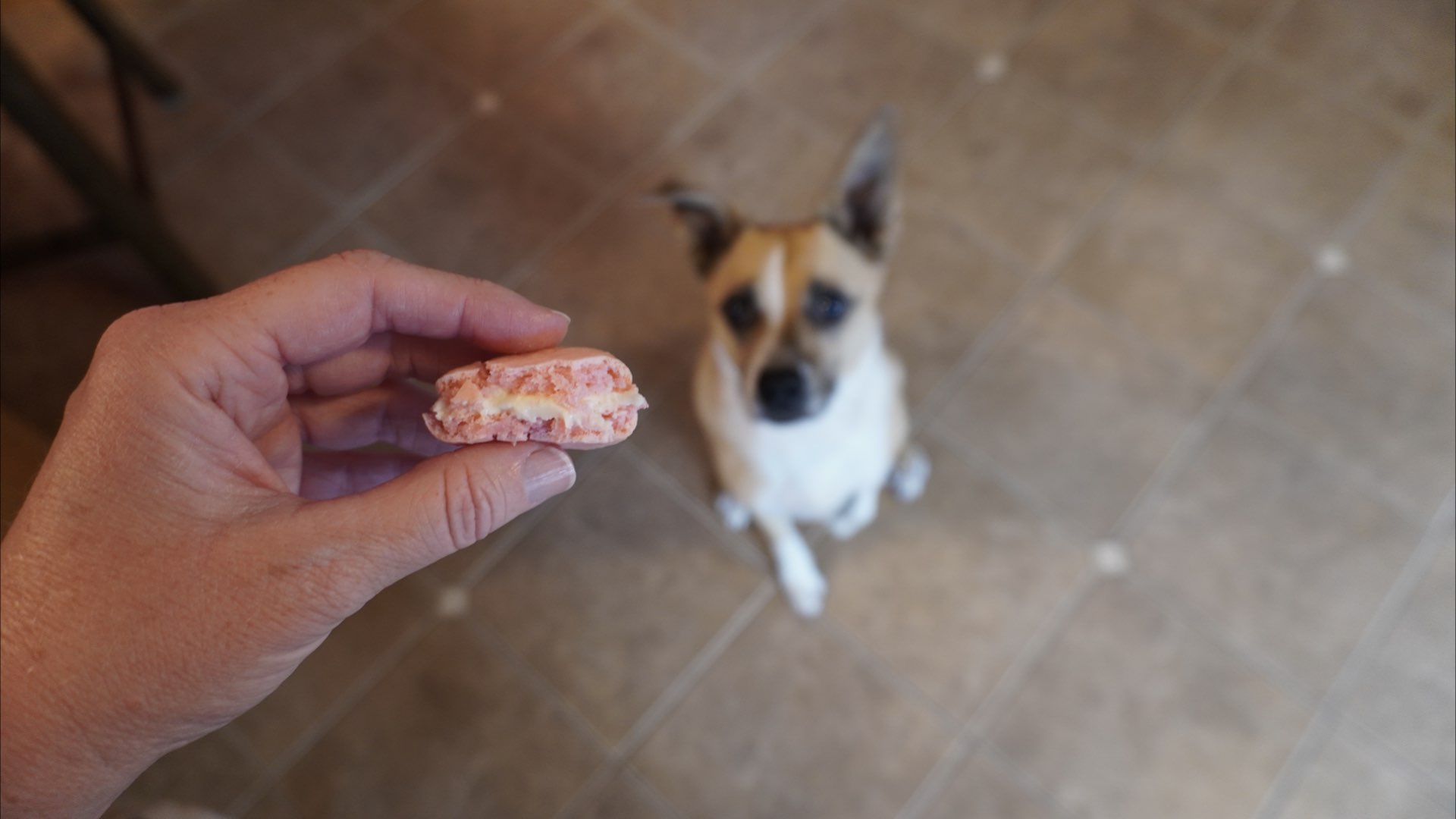

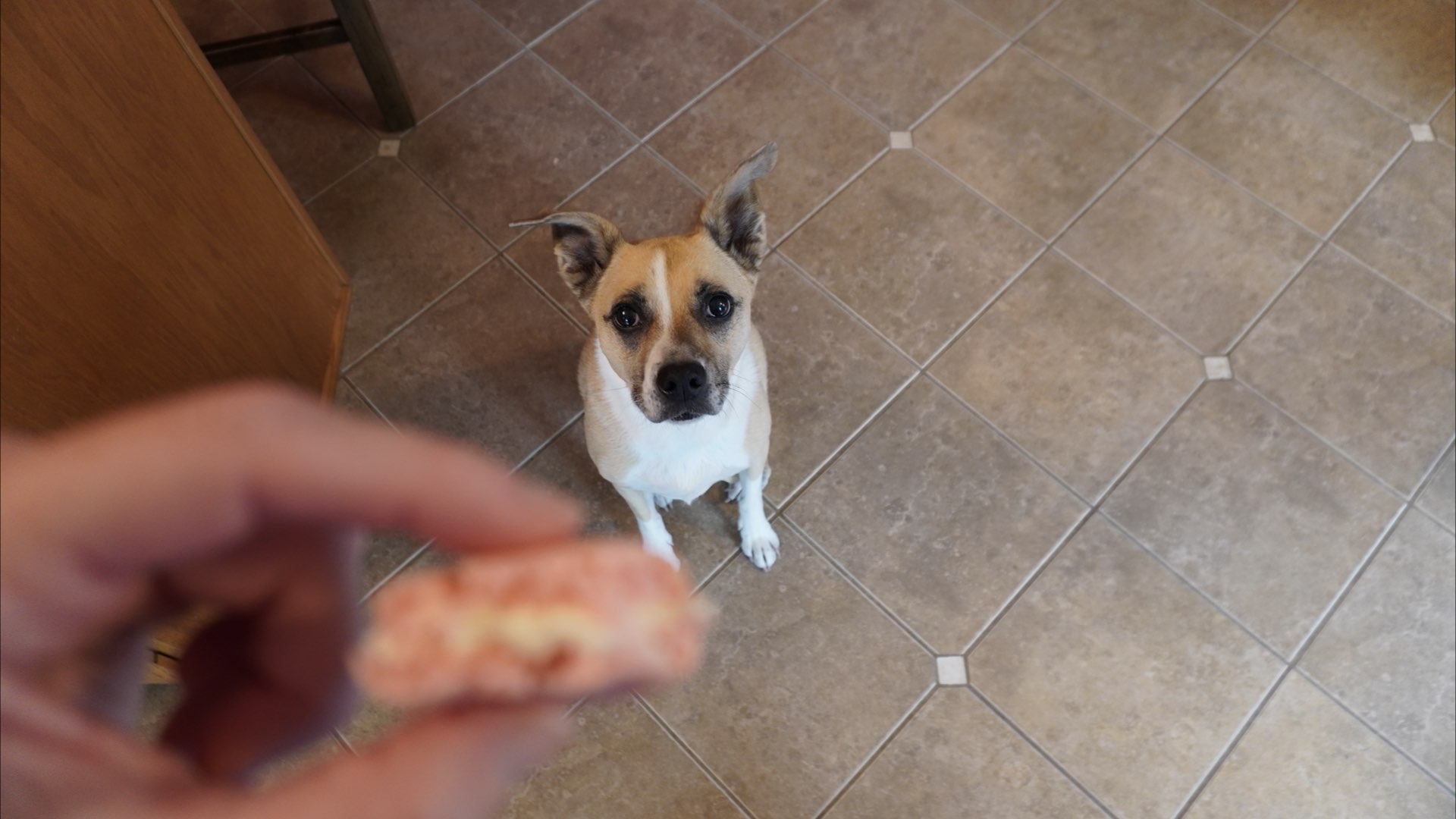
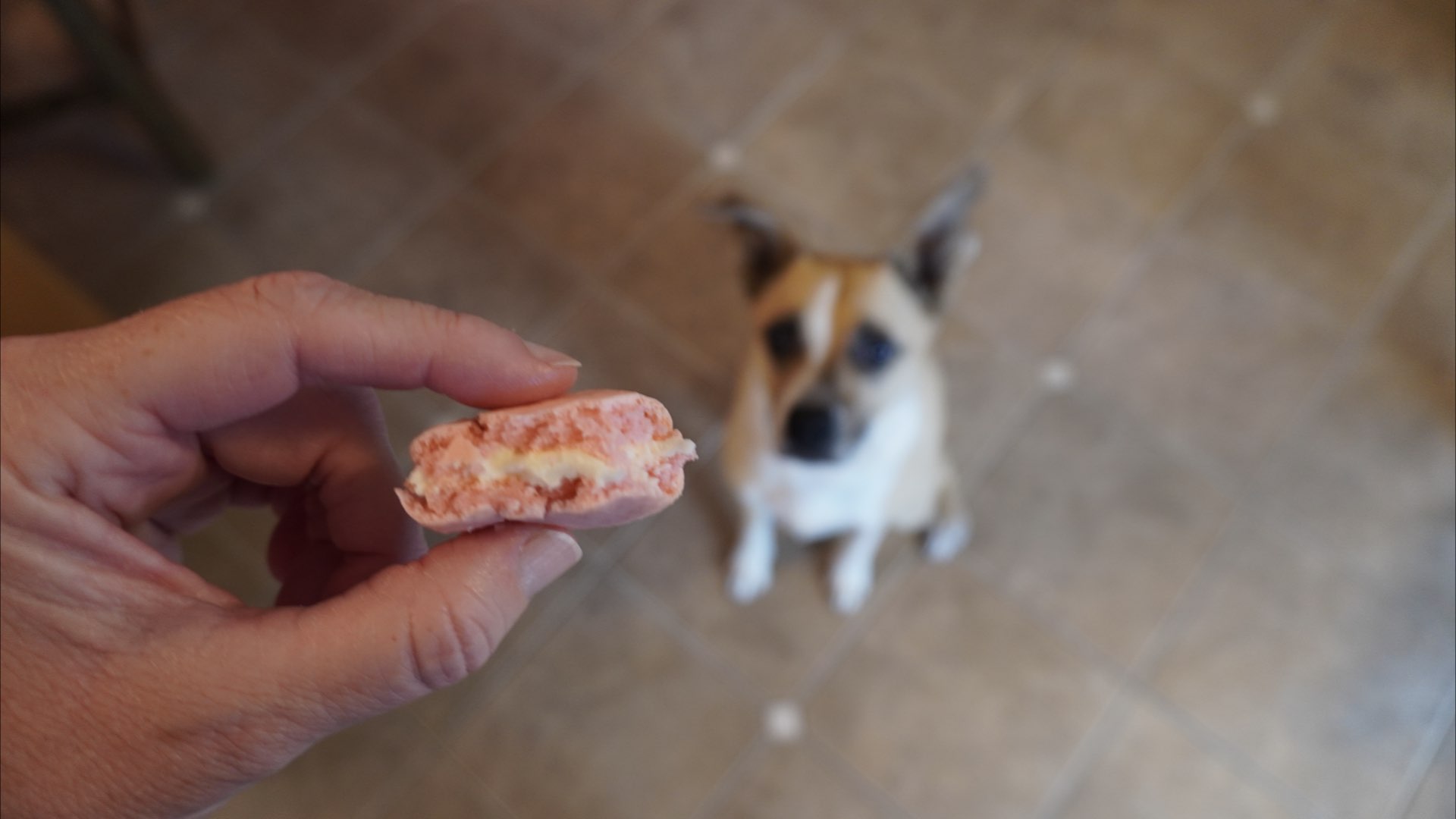


Bake lots of them now and send us updates. Make so many to the point your friends don’t want to look at another macaron. And don’t worry if you have an occasional cracked shell, funky feet, or uneven cookie. They all taste great!
If after trying the recipe, you find yourself struggling, go to my troubleshooting guide for many common mistakes and how to correct them. Also, feel free to contact me for help. I want you to succeed!

French Macarons
Ingredients
French Macarons
- ¾ cup (100g) powdered sugar
- 2 large (60g) egg whites
- ½ cup (50g) almond flour
- ⅛ cup (30g) granulated sugar
Basic Buttercream
- ¾ cup (100g) powdered sugar
- ¼ cup (56g) softened butter
- ½ tsp (2.5 mL) vanilla extract
- 1 tsp (5mL) milk
Instructions
- Sift powdered sugar and almonds together. Set aside.
- In a 2 quart bowl or larger, use a hand mixer and beat eggs for 30 seconds, add sugar. Continue beating until soft peaks form. If desired, add food coloring at this stage. Beat until just combined.
- Add the dry ingredients into the meringue.
- Using a spatula, gently fold in the ingredients until batter becomes shiny and drips smoothly off the spatula. It should ribbon off and sink back into the batter within 30 seconds. If it doesn’t do this, fold until you see the change. Do not over mix or you will have flat cookies.
- Place in a piping bag with a 1/4" (6mm) tip. Squeeze onto parchment paper or a silicone mat until 1 1/2″ (3.8cm) circles form, spacing 2″ (5cm) apart.
- Let sit until a skin develops. This step will depend on the humidity in your environment. On dry days, it can take as little as 15 minutes. When it hits above 75% humidity, expect it to take 2 – 3 hours. Failure to dry the cookies will often result in cracks and cookies without feet. (Feet are the little ruffles that develop at the bottom of your cookies.)
- Once the skin forms, preheat the oven to 300F (150C.) Bake 18 – 20 minutes.
- Let rest 5 minutes and remove to a rack to cool completely before filling. I recommend an acidic flavor to balance the sweetness of the cookie.
Buttercream Instructions
- Blend sugar, vanilla, and butter together. You can use a mixer or mix by hand.
- Add in the milk if desired for a softer buttercream.

Hi there,
Thank you so much for the instructions and video. I find them very useful. I made the 1st batch. Unfortunately I had hollow macarons. I have a stand mixer with 10 levels of speed. At what speed do you suggest I should use. I started it out at 5 but after 20 mins of beating the white didn’t seem to come to the soft peak so I went up a notch to 6 and that helped. Do you think I over-beat the white at that point? Thank you in advance for your help.
Hello Thanh, 20 minutes is a very long time for your whites to need beating. This indicates to me that a trace amount of fat either on the bowl or a bit from an egg yolk snuck into the whites. I would play around with your mixer speed as every mixer is a bit different. If you see large bubbles forming in the egg whites, turn it down until the bubbles are more uniform so you won’t have pockets of air. When I get hollows it is always down to either over beating the egg whites, underbaking or overmixing the batter. I hope this information helps. If you are still struggling, let me know and I’ll be happy to help further.
I have a question about food coloring. I have Wilton’s gel food coloring (pastels) and 3 drops of the aqua comes out VERY light. Not even quite baby blue (more like a bluish white); however, I want a deeper aqua (think 1980s). I experimented with a batch (that I had to toss) last week and it took 14 drops to achieve the color I wanted with another recipe. Will adding this much gel coloring to your recipe ruin the ratio?
Hello Bre,
It can “break” a meringue if too much food coloring is added, but it usually takes more than 5mL (1tsp) to do so. However, I will let you know that wilton’s gel food coloring is quite notorious for needed so much coloring in macarons that it often leaves a horrid chemical taste and makes people’s mouths and teeth stained. They are also known for lightening as they bake. You’d be much better off ordering Chefmaster, Americolor or Sugar Art Master Elite powder to get really vibrant colors. I’ve been able to get them from Amazon. Hope this helps!
Thank you for the recipe and video explanation. They come out nice and soft inside; however, for some reason, they rise pretty well at the 10th minute, but then they significantly decrease.
Hello, Artem.
It is natural for a macaron to rise and fall as it bakes. As long as the center isn’t concave and the inside is fully baked, this is normal and should be expected.
However, if the macarons rise and fall significantly, there are several things that could contribute to this happening.
One, your oven is a bit too hot. The meringue rises fast and then before it has a chance to “set” the shell is hardened and the inside isn’t fully baked to support the weight of the shell. A simple fix for this is to reduce your oven by 25°F or (4-5°C.)
Two, you didn’t bake the macarons long enough. This one is a little tricky as too long, they become crunchy. I have found to make a “test” batch and pipe just a batch onto a smaller pan to find the right temperature and time for my shells. That way, I’m not wasting the entire batter if my macarons are a little too crispy or soggy.
Finally, I have found some silicone mats to be a contributing factor. There are some brands I have tried that cause all kinds of issues with macarons in general due to them being poorly made, too thick or just preventing the shells from drying properly.
I would suggest first lowering your temperature and increasing your baking time from 2 to 5 minutes. Hope this helps!
What amazing and thorough work. Your dedication is commendable! I created a recipe comparison chart of my own, but I lack the stamina it takes to actually test all the variables. My macs are pretty and tasty but hollows are an ongoing problem. So I’m intrigued by your recipe and technique and will try it ASAP. Could you possibly share the sources for the original French recipe?
Hello Lucy, I wish I could share with you the chart I made. I do have a photo of part of it here, but sadly, I lost the file years ago.: https://jacksonsjob.com/wp-content/uploads/2019/07/french-macaron-rec-chart.png I will share what I did and perhaps you could replicate? I wrote down every recipe I could find and compared them until I found a common pattern mathematically. I then did research and found that there are many different methods and variations for macarons: French, Italian, Swiss, Korean, Japanese, American to name a few. At that point, I started researching .uk sites to find the history behind the macaron. This was the first article that popped up: https://www.bbc.co.uk/travel/article/20220516-the-true-origin-of-french-macarons At that point, I started researching the names that were credited for creating the original recipe and was able to find French websites that I had to put through a translator to read the recipes. I kept plugging the recipes into my spreadsheet and found the most common and successful recipe with the oldest roots to be the ratio I use.
I will share that ratio with you below. I am copying and pasting from youtube, so some of it may not apply.
Original Macaron Ratio
I will give the ingredients below in both US cups and in grams since I am not sure which you prefer to use. The grams is the most accurate, but the cup measurements will work well.
The recipe of the original macaron is actually based on two ratios. It is as follows: for every gram of egg whites, you will need 1/2 the amount of granulated sugar by weight. So for 30 grams of egg whites, you would need 15 grams of granulated (sometimes called fine or castor) sugar.
To find out how much almond flour you need, you divide the amount of egg whites by 1.2 to get the total amount in grams. So 30/1.2 = 25 grams.
For every gram of almond flour, you need twice the amount of powdered (also called confectioners or icing or 10x) sugar. So for 25 grams of almond flour, you will need 50 grams of powdered sugar.
French Macarons
¾ cup (100g) powdered sugar
2 large (60g) egg whites
½ cup (50g) almond flour
⅛ cup (30g) granulated sugar
Basic Buttercream
¾ cup (100g) powdered sugar
¼ cup (56g) softened butter
½ tsp (2.5 mL) vanilla extract
1 tsp (5mL) milk
I truly hope this helps you somewhat and I’m sorry I didn’t keep the original work. I was mainly documenting my own journey to learning macarons through failing and never imagined anyone would read this website! Perhaps this will help you in your own research? Let me know if you have anymore questions.
Thank you so much for the recipe! I was able to make my first decent batch by following it 🙂 The step-by-step photos and explanation, let alone the troubleshooting videos, make a huge difference. There are many recipes out there but when you don’t know the small things that matter it will not work out. I couldn’t crack the Italian meringue but this one is much better. I never comment on websites, but this time I just had to!
I am so happy you had a good batch of macarons, Julia! The more you make them, the better you get as there is a bit of a skill that develops over time where you learn your oven, your own folding style and how much you deflate the batter just through transferring it into a piping bag and squeezing. If I can ever be of help in your macaron making, send me a message. I love helping others perfect this little cookie no matter which recipe they end up using. Thanks for commenting. I feel honored you took the time! We always appreciate feedback, good or bad to help fellow bakers out there. 😀
I must thank you a ton, I’ve tried a different recipe and ended up with macarons with absolutely no feet, i saw your recipe on youtube a few weeks back and decided to try it today, and somehow they formed perfect feet on my first try doing this recipe!
That is fabulous to hear, Joe! Sorry that it took so long to reply. I’ve been a bit under the weather lately. I am very impressed you were successful on your very first try! It took me MONTHS to figure out how to make macarons when I first started. Have fun creating all kinds of delicious flavor combinations. Your imagination is the limit!
Do you age your egg whites or just wait til room temperature after separating?
Hello Nan, I do not age egg whites and often don’t wait for them to come to room temperature. I have used them fresh from the chicken coop, straight from the fridge, aged and cold. All will produce excellent macarons. Eggs that are cold and fresher will be easier to separate from the egg whites and egg yolks are more prone to breaking as they age or at room temperature. Cold egg whites can take a little longer to whip, but it’s not a long time. That’s the only real differences I have noticed over the years of making macarons. I hope that helps!
Hi Jackson! I was just about to give up on macarons(no feet, hollow thin shells) until Blamo! Here you are! I’m gonna give ya a try and not go to stiff peak and maybe just macronage to ribbons and call it good…rest for an hour and see how we do…you’ll be the second person to know!! I’ll report back! Promise! One quick question before I give it the good o’ college try one more time: do you ever use cream of tartar and if so how much? 1/8-1/2 tsp.? Or would it lend to the stiff overbeaten egg whites I’m so trained to do? Thanks for ALL your helps and tips…gonna go bake!!!
Hi Cheryl, Much luck to you! Macarons are 1/2 the recipe and 1/2 learning the skillset. Keep trying no matter what recipe you ultimately end up with as once you get it, you get it! I’m here to help you learn anyway that I can and am happy to steer you toward other methods that have been successful for others.
The answer to your question: cream of tartar is an ingredient I don’t even have in my house at the moment and avoid using. Potassium bitartrate found in cream of tartar is thought to be the result of kidney failure associated with grape and raisin ingestion in dogs. I am prone to dropping things due to my arm issues so I don’t even want to chance one of our beloved pets getting ahold of the ingredient as there is no cure and treatment is so-so.
However, if wanted to try it, I would go for 1/8 or a pinch for every 60 grams of egg whites (2 large eggs.) It does help hold the air into the meringue, so it would be a little added insurance.
One thing I have done in the past is add either 1/2 tsp of white vinegar or lemon juice into the egg whites when the eggs were really fresh as it just helps them whip up faster. I hope that helps and let me know how it goes! Much luck to you!
I just tried your recipe and was amazed at the results. I did have a challenge controlling the piping, as the batter was easily flowing from the bag. Honestly, I thought I had a major fail on my hands. To my disbelief, I wound up with full macarons that were fabulous! Thank you so much for sharing your expertise!
That is fabulous news, Linda! To gain a bit more control, you can use a smaller nozzle or just snip a small hole in the bag without a nozzle present until you get the hang of working with the batter. It takes a little practice! I still use a small 1/4″ (6mm) nozzle as I’m too slow to work with the larger sizes. 🙂
Thank you for the tip size suggestion! I will definitely give the smaller size a try.
You’re very welcome, Linda! I hope it helps you. 🙂
Hi.. I am so glad i found you !! I’m definitely gonna try your recipe.
But can u pls guide me on oven temp and settings. Do u keep both rods on and fan on? My fan is very strong.
Hi Sabina, our ovens are a bit different over here in that they almost always automatically turn on both rods for the preheating cycle and the bottom is most often used for the baking cycle. In more modern ovens, both rods are sometimes cycled on and off while baking. I do use convection for even browning, but it isn’t necessary. I would stick with just one rod (the bottom if it’s optional) and try first without the fan and then again with the fan. If you don’t have on the fan, around 10 minutes, turn the baking tray 180 for more even baking and to ensure they don’t become lopsided. Hope that helps!
Your recipe is great, but I’m new at this so my piping didn’t come out so great. I’m going to try again another day. Thanks
Hello Rprejean,
The piping gets easier the more you practice. If it helps at all, I will squeeze slowly, count out to 6 and release pressure. That helps me make them more even.
I can’t wait to try, can i double this recipe to make more ?
Hi Audrey! You can absolutely double the recipe, I often do. However, when new to making macarons, I do recommend the recipe as it is so you don’t waste ingredients as you are learning how to make them. They can be a little tricky to master so starting out with a smaller amount will make it easier to learn.
Hello! I have made macarons multiple times. but I don’t always get the feet. Today I tried your recipe, and they turned out beautiful! However, they were a little on the crunchy side of things. I baked them at 300F for 20 minutes. Any suggestions on how to have bright color and not as dull and crunchy?
Digna, that is wonderful new about the macarons turning out beautifully! Congratulations. There are a few answers to your questions so bare with me. Temperature will dull some types of food coloring and not others. This comes down to the quality of the food coloring and often what country you are from. Here in the US, we have access to super concentrated dyes that are illegal in many overseas countries due to the health risks. So the colors you see online are often made with these types of food coloring. If you get super bright reds, purples or deep blacks, they often change the taste as well to an unpleasant bitter taste and color your teeth and tongue. However, if you are just trying to use ordinary colors and they are slightly fading, then lower your heat to 275°F (135°C) and increase your baking time 3-5 minutes. You can even drop it lower, but will need to increase the baking time further to compensate.
Now the crunchy: is the meringue itself crunchy or just the exterior? If both the interior is crunchy, this just means the macaron was slightly overbaked. Every oven is different and so are the pans used. So it takes a little trial and error to get the temperature and time just right. Try backing off the temperature a minute or three. Bake at one rack lower than center. Some pans will bake macarons much faster like thin aluminum as opposed to a thicker steel. And darker pans will make the exterior more brown and also dull the food coloring. If you are using a darker pan, reduce the heat 275°F (135°C) and try again.
You can go ahead and fill the crunchy ones and let it mature 2-4 days and it may soften to a better texture. Since you are having dull color and crunchy texture, I do suggest lowering the temperature 275°F (135°C) and then just playing around with that time. Start out with 22 minutes and check them. Adjust up or down depending on how they turn out. It’s all a matter of learning your oven and how macarons like to bake inside it. Let me know if I can be of more help!
Hi there its Afy from the UK. I have been commenting on your videos and how I’ve been struggling with no feet and hollows. You recommend going to soft peaks instead. I can say that this has improved the size of feet but still quite small. All credit goes to you and Anna Olson 👍👍👍❤️❤️❤️. You are amazing..totally.. I’m still not quite there with these cookies but maybe I do have hope now thanks to you.. ❤️ what can I do with getting bigger feet they were so high feet in oven in first 5 mins then by 10 mins they go so tiny.. any tips?
Hello, Afy!
After I replied to you on YouTube, I came over and saw this reply you left. As we discussed, you want to tinker with the macaronage and drying times. And we also discussed the oven temperature.
However, you did give me a little clue with an extra detail over here: your feet rise and then collapse during the baking process. So let’s address that specifically!
First, make sure not to open your oven before 9-11 minutes has passed. This will make sure just like meringues in general, it doesn’t “fall” with the gust of cool air from the surroundings. Especially on a cold day.
Second, I really do recommend folding the macaron batter one or two turns less than you did with this description.
Lastly, do tinker with your oven temperature a bit. Instead of 150C, try dropping down to the next temperature on your dial and adding 3-5 minutes to the bake time. If that doesn’t work, up the temp to the next dial and decrease bake time 3-5 minutes. I really do think this is coming down to just a slightly over mixed batter or the temperature of the oven just needs tweaked a little bit. Hope this is helpful!
Just want to send some feedback, your recipe is the best!
I have baked macarons for about 2 years and from time to time fail but using your recipe I always get great result. I have shared your recipe with friends so now they also only use yours.
Greetings from a grateful Swedish macaron baker.
Hanne, I am so happy to hear you are getting great results with the recipe over in Sweden! This is truly wonderful news and I’m glad it is helping others bake fabulous macarons across the globe. Have a lovely weekend. 🙂
Where it calls for crushed almonds do I use the almond flour in its place?
You can either make your own blanched ground almonds or use almond flour that is manufactured for you. The almond flour is more convenient for most bakers. Hope that helps!
I’ve only tried to make macarons once in my life and they didn’t turn out so I never tried them again. I tried your recipe and method yesterday and made 2 batches and they both turned out perfect!!! Will definitely be making them again! Do they freeze well?
Melissa, that is fabulous news! Congratulations on conquering the world’s most difficult cookie in such short order. Only took me over 6 months. 🤣😬😳
So the freezing is kind of subjective. We read it could be up to 6 months, but the most I would recommend is 6-8 weeks, more toward 4-6. We’ve tried it and this is what we determined. Freezing the shells without filling them works best. Freezing with the filling works, but they don’t taste as good starting the second week. By week four, they are mushy when they are thawed. Just the shells can last up to a month before turning olds textured. But I would freeze them and take one out each day and have people taste them. After about the 3-5 day, you start noticing a degrading in texture filled and 5-7 just the shell. So I suggest next time you have extra space, freeze a batch. Do the same. Label the top of the container and freeze them. Take one out each day and write down when they no longer taste good to you. Then you’ll know how long you personally want to keep them.
Buttercream freezes very well on its own and I’ve had it last for a good solid 4 months before the texture and taste goes awry. I hope this helps! If you try it, let me know what you think. 😊
My macarons were cracked even though I rested them for 6 hours until they were dry 😭 this isn’t my first time making macarons too
Oh no! I’m afraid six hours is way too long to rest macarons for this recipe. I frequently have 99% humidity levels and have never had to rest longer 1 3/4 hours. If they dry out too much, you can end up will all kinds of odd issues like cracking, uneven feet, or mushroomed tops. You are also risking food spoilage or illness as they are made with eggs. Always follow food safety guidelines when it comes to raw ingredients such as eggs, milk or meat. The tops should not be hard/dry, but rather they should have a skin that is pliable and easily dented but batter doesn’t stick to your fingers. They are called the world’s most difficult cookie for a reason. If you want to try again, I strongly recommend weighing your ingredients and not resting so long next time around. And if you are still having issues, you can contact me for further help or check out my troubleshooting guides. Have a great weekend!
Hi there,
I am lucky having a chance to read your recipe. I am going to try your recipe soon. I hope this will work as I had done many attempts and always failed (cracks and no feet). I always beat the meringue until it reached the stiff peak. I first tried with oatmeals flour more and a few with almonds but never successful.
I would like to try you recipe with oatmeals flour, how many grams would you recommend?
Hello Cicy! I would recommend swapping out the almond flour equally and use 50 grams. That’s what I’ve done when I’ve tried other types of flour and it seems to work out okay. Flavor wise, it’s a toss up on how they will taste. French macarons are such a tricky cookie to make, aren’t they? Hang in there and you’ll get it mastered. I’m here for questions along the way. I finally started having success when I stopped beating the meringues to stiff peak.
Love this recipe. Thanks for researching and all of your hard work. It took a few tries (like six) but now I have it and it makes a really nice present. They taste perfect! We have a new French bakery and I wanted to match what they make. I did with your recipe. 😍
You are very welcome, Lynn! I was blessed at the time to have an exchange student in my husband’s class that cheerfully ate hundreds of failed macarons for months until one day he said “This taste just like the ones in Paris.” You got them really fast that I’m impressed. Enjoy your macarons and learning to make all kinds of flavors!
Thanks to your recipe! I still have a lot to work on, my piping and being consistent. I laughed about your exchange student! My husband eats them as fast as I can make them. Great instructions and recipe. You’re the best! 😍
Your husband and mine have something in common.
He likes just the shells even. If you have broken shells, they taste great sprinkled on ice cream and other snacks. Our dog loves them so much her nickname became Macaron Maggie. I’m hoping to get a video out soon of the recipe to help even more people. You will get better with consistency as you practice. Time takes care of that. I actually count out the same number as I squeeze, release and then lift. It really helped me to make consistent sizes. Having fun makes a huge difference in perfecting these little delicious monsters.
100 Stars YAY!!!!! Thank you, Thank you. After countless inconsistent attempts I stumbled across your recipe and it has been extremely consistent for me for half A dozen batches and counting. I love this recipe for its dense fluffy inside which I just could not achieve with other recipes. I found that the smidgen under 2 inches seems to puff the best for me. You have provided a great service to us all, experienced or novice. This is now my forever recipe, the rest I am going to officially round file 🙂 and I thank you again.
Lynn, your comment made me smile as I truly enjoy helping others become successful bakers and it all started with this little cookie. Also, you are quite funny. I like that phrase “round file.” It took me a moment to get it. 😀 Enjoy making macarons! Pretty soon you’ll be a pro at them.
Is it possible to use a stand mixer for the meringue and macronage process? I find I get better results(good feet and rise) that way but I still have issues with the cookie coming out chewy and not crisp at all.
Hi Chad, You can definitely use a stand mixer for the meringue process. The macronage is a bit tricky but doable. You have to watch it very carefully, but since you already have good results with it, you shouldn’t have any issues adapting this recipe for the stand. If you want the cookie to be more crisp overall, add more time to the baking about 5-10 minutes and lower the temperature 25F (4C.) You will have to do a few trial and error batches to get it just right as every oven is a little different. Congratulations on getting good feet and rise! That’s most of the battle right there.
Hi, I tried your recipe last night.
I noticed that after I piped them that they expanded a little more so next time I will pipe them a little smaller. They came out with a small hollow on the top. I don’t know if is my macronage or an oven issue. I would love to see a video of your meringue and macronage. It would be most helpful. I must say that the batter didn’t get thick which is a big problem I have with other recipes. I will try your recipe next time and the next time until I they come out with no hollows. Thanks so much!!
Lizzy
Hi, Lizy. It honestly could be a little of both. The fact you said they expanded a little more does make me think you could have mixed it a couple strokes more than ideal. Don’t worry! You will get better as you go. I helped a young woman that now uses this recipe to have a small macaron business that is quite successful. I’m more than happy to help you master this finicky cookie as well. You can continue to comment or got to the “About” page and send me an email (it’s at the bottom of the page and says ‘Still have questions? Contact us.’) for more one on one help. It should flatten, but not really spread out after you finish piping. The oven can also cause hollows if you don’t fully bake the macaron. Meringue will settle a bit if it’s not fully baked (think how cakes can collapse in the middle.) The best way to find out if it is your oven or macaronage is to over-bake some cookies. Add 5 minutes to the bake time for a small batch and 10 for another small batch. Let them cool completely then check them. I like to pipe about 3-6 on a tray when practicing so I can find the right baking time. If it is your macaronage, no amount of added time will fix the hollows. If the hollows are fixed with the added time, then you know you need to tweak the oven temperature.
A lot of macaron recipes tell you to under-bake the batter based on their misunderstanding of the Italian and other heated meringues needing less baking time. Every oven is a little different. In many recipes overseas and many of the top pastry chefs, they slightly over-bake the meringue so it doesn’t collapse, is slightly crisp and the frosting inside will soften the cookie naturally within 1-2 days. That’s why so many recipes tell you they are best 2-3 days later. I do plan to do a video as soon as my shoulder heals enough to make macarons again. In the meantime, I do have a meringue video if it helps at all: https://jacksonsjob.com/meringue-basics/ The peak will be similar to what you see around the 1:55 mark, but less pronounced. Feel free to keep in touch until you get these right. Have faith, you will get there! They are called the most difficult cookie for a reason. Good luck!
Thank you! I’ll very careful not to over mix next time. Sometimes when I’m macronaging I keep going because I see air/bubbles and I think that may be the reason why I’m not not getting full macs. In other words, I’m not sure when to exactly stop mixing. I did add 1/2 teaspoon of egg while powder. Is like I’m afraid not to add that or cream or tartar even though makes no difference , I still get hollows ! Lol
Lizy
I so relate to your struggles. I did this for months before I started reading and translating French websites. That’s how I figured out how to finally macaronage. If you see air/bubbles, you won’t get hollows. You will only end up with a pocket of air the size of the bubble here or there. Think of how when you bake a cake or bread and sometimes there is an air bubble in a slice but the rest is good. If they bug you, you can prick the bubbles with a toothpick after piping. So I recommend playing around with a batch. Do a few stirs, using a spoon, plop a spoonful or two on a baking onto a baking sheet. Do a few more stirs, another dollop. Do this for the entire batch. Make the batter completely loose in the end. Draw a little grid on a piece of paper as you go and write how many times you stirred and what the batter looked like at that level. It’s a fun way to see how macarons work. You’ll really get a feel for macaronage and understand how the meringue holds it structure. Also, what you are looking for is this: When you stir, lift up some of the batter. You want it to fall off the spatula at a moderate pace not fly off. The batter that falls off into the bowl should level back out by the time you count to 30. If it doesn’t level off and just sits on top, then you need to do a little more stirring. You want the consistency to be similar to a slightly melting soft serve ice cream, not thin like store bought cake mix batter. If it’s like a cake mix batter, then you will have hollows. The batter will go from a matte, grainy look to just starting to get a sheen to it. Think satin paint, not semi-gloss. If you get to the super shiny stage, it’s overmixed.
Thank you for this! I’ve been struggling to perfect a recipe that I realized might have way too much sugar in the meringue. I was over whip because it took forever to incorporate it. Now, if I wanted to add coffee flavor, do I need to adjust the ratios? I would add 1 tsp of espresso powder for a recipe this size.
Hi Alison, what I personally have done is take the powdered sugar from the sugar/almond ratio and replace with equal amounts of coffee, cocoa, freeze dried fruit or spices by weight, but a teaspoon swap of the two would likely work as they would be very similar amounts in grams. A gram here or there won’t break the mixture. If the flavoring I’m using is on the oily side like lemon zest, I remove some of the almond flour instead because almonds are oily and powdered sugar is dry. I hope that helps!
This is priceless. I am a novice to macaron making but found your posts so comforting. I’ve attempted two batches so far (very similar to your #8 & #11). I can’t wait to try your recipe next. Thank you for the time and detail put into this.
Hi, Natasha! So glad you are finding this helpful. I went through dozens of batches and months before getting it right and that was with an injured arm. Hopefully, you’ll get the knack of them sooner than I did! My tip is to start out by under mixing slightly. A cracked and puffy cookie always tastes better than a hollow flat one. If you need help along the way, feel free to ask away. I’ve taught lots of people since then and a few are even making them for some extra cash now. 🙂
I finally made these and they were perfect. The taste and texture reminded me so much of the Laduree ones I love. The pictures for mixing the meringue helped tons. I piped mine a little smaller so I reduced the bake time to 10minutes. Thank you very much for all the effort and detail put into this recipe.
Natasha, I am so glad you had such success with the macarons! That’s a very high compliment to say they taste like the ones from Laduree. That made my day. 🙂
I used your recipe after attempting 2 of the aptly named other recipes you mention….
They turned out really well on my first effort.
My husband suggests that you and I are very similar women and what a shame it is that you live in the USA…(I presume?) and I live in New Zealand as we would make great friends! 🤣.
Thank you so very much for your fabulous recipe and generosity in sharing.
Hello, Joanne! I am so happy to hear they turned out well on your first effort. That means they are only going to get better from here on out.
It is a shame we are far apart! I would invite you over for some baking fun. Yes, in the USA. I have a friend that lives in New Zealand. Maybe I should introduce you all. She’s much more fun than me, too! 🤣 Your husband and my husband would likely get along then, too. They have great taste in women. 😁
Hi, can I ask you a question? I am interested in trying the regular-flour-recipe because I’ve wasted way too much of almond meal. How much flour are you recommending? 1:1 ratio? Thank you, V.
Hi Veronika! I indeed used a 1:1 ratio of white flour in place of the almond flour. I also recommend purchasing the cheapest eggs out there. I practiced like this until I felt more confident to try almond. Once I felt more confident, I started replacing some of the white flour with almond. For instance for every cup, I would do 1/4 cup of almond and 3/4 cup of wheat, then 1/2 cup almond and 1/2 cup wheat, followed by 3/4 cup almond and 1/4 cup wheat. Once I had that down, it was easy to go over to the full almond flour.
Thank you for your guides and recipe! They are so helpful! After trying out other recipes, this had produced the happiest results! I’m glad I found your page and troubleshooting page as well. I’m not much of a baker (pretty terrible actually), but after going through your guides and practicing a dozen times, I’ve been able to make some great macarons! Thank you! 🙂
You are very welcome, Francesca! You’ve made me quite happy as it is my goal to teach those that aren’t confident in their baking skills feel more comfortable in the kitchen. Macarons are so difficult. The fact you’ve mastered them means you are a great baker. Enjoy creating all kinds of flavors. 🙂
Seems like a lot of powdered sugar for the amount of almond flour? I worry about the shells being overly sweet. I use 65 grams of almond flour, 65 grams of powdered sugar, and 50 grams of egg whites.
I will definitely try beating my meringue to soft peak instead of stiff peak stage, as I’m finding that my batter is often too sticky! No amount of macronage will get it to flow like it needs to. It stays sticky, and my shells crack. This issue occurs about 50% of the time, and drives me mad!
Hi Heather! This recipe is one of the original french macarons recipe from hundreds of years ago, just in a smaller batch. When it comes to making a macaron with the french meringue method, the ratios of almond to powdered sugar is critical. You sadly can’t make them less sweet using this method. The ratio you are mentioning is more like the Swiss or Japanese modern styles and I’ve found they don’t give consistent results or taste like a traditional macaron. The batter is just like you describe using that method as the powdered sugar is what “dries” out the meringue and the batter allowing you to macaronage. In Italian, Swiss and Japanese methods, you never really macaronage the batter as it’s a much stickier consistency, rather you mix it to a glossy sticky consistency and tap them down firmly. Drying is essential for those methods as they will crack more often. Traditional macarons like the ones showed here are very sweet cookies and it’s why they balance them with bitter fillings like lemon curd. Hope that helps explain the difference. Also, for those methods, going to soft peak stages may not do you any good. This method is specific to the recipe here. I cannot promise it will make a difference in recipes I’ve not personally tried it on. Keep practicing and try other recipes out. You will get better with time. I helped teach a woman that now has her own macaron business and am glad to share any knowledge I have to help you succeed.
Hello, your recipe is the first that I have seen that whips the eggwhites to soft peaks instead of stiff peaks. Just wondering what effect stopping at soft peaks has.
Hello, Therese! When you beat a french meringue to stiff peak, the meringue cannot not grow any further in the oven and this makes the cookie prone to either collapsing or cracking. If you use soft peaks, it allows the meringue to expand and stabilize while in the oven. The main thing it prevents is hollow cookies and gives it the traditional french style. There’s a lot about macarons on this website in regards to how I developed the recipe and troubleshooting if you are interested: https://jacksonsjob.com/macarons-macaroons-or-mayhem/
Thank you for this recipe! I tried two other ones before and got a hot mess of flat discs with splayed feet. These look very nice! They rose beautifully and look almost professional. They browned a little which is unfortunate but I will try to reduce my oven temperature a bit next time.
Cynthia, So glad this recipe worked out for you! There is nothing like finally making your first successful macaron! If you reduce the temperature, you may need to add up to 5 minutes baking time on the total bake. Every oven is a little different. Have fun creating all kinds of flavor combinations!